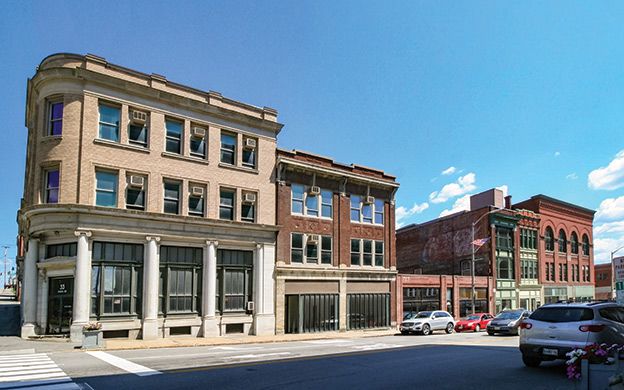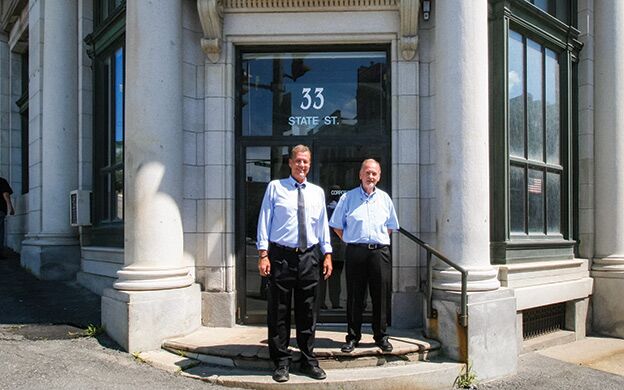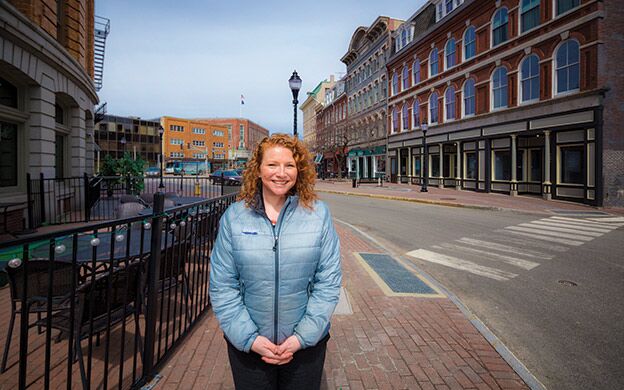Sale of Bangor block a cornerstone of downtown revitalization
The pending sale of a block of historic buildings is viewed by the city as a great opportunity to leverage revitalization efforts going on in the downtown and waterfront areas.
Together, the six buildings — located on Exchange Street, between State and York streets — comprise 52,945 square feet. The asking price was $1.95 million.
The buildings are being sold as a package that will not be broken up, says John Bonadio of Maine Commercial Realty who, with Pete Laney of C21 Venture Ltd., is marketing the package.
An offer has been made on the property, but the potential buyer wants to remain anonymous for now, the brokers say.
“The buyer is a property developer. We have been asked not to reveal the buyer's name until after due diligence,” says Bonadio.
The downtown parcel has been marketed as “ripe for development into a mixed-use showplace,” possibly with offices, retail, restaurants and luxury apartments.
It was on the market just a short time before the offer was received. It hit social media before Bonadio and Laney even had a chance to finalize their brochure on the offering.
“I sent a copy of the draft brochure to Bangor Economic Development and it hit social media — and we've been swamped,” Bonadio says on a tour of the block in early August.
After a century of disparate owners, “It's really only been available to the general public now,” he adds.
For years, the block has been “drastically underutilized,” says Tanya Emery, Bangor's community and economic development director. Ideally, she says, redevelopment of the block would continue the momentum elsewhere in the downtown, attracting additional visitors and investment. She envisions a continuation of downtown Bangor's recent surge in new retail, restaurants and living quarters.
“We've seen such changes in downtown when large spaces are rehabbed and become productive again,” Emery says.
Two historic buildings, 25–27 Broad St. — featuring an unusual curved façade — and 28 Broad St. are good examples of transformation in recent years, she says.
“They were dormant for decades,” Emery says. “When those were purchased separately and rehabbed by developers, all of sudden that block feels different. You round the corner not into a dark, unused area but into the light,” with high-end residential activity and eateries. “So the city is excited to see this piece of the downtown, which has been a little dark, really come alive.”
A block with a distinctive past
There's plenty of history behind the Exchange Street block, which was “once the heart of Bangor's social scene and filled with bars and restaurants,” Bangor Historical Society Executive Director Melissa Gerety writes in an email to Mainebiz. “The ballroom of the Nichols block was a popular place.”
Gerety is referring to the grand ballroom on the third floor of the oldest of the six buildings, on the corner of Exchange and York. “Nichols Block 1892” is engraved on a granite block on the façade. According to “Bangor, Maine — 1769-1914 Architectural History” by Deborah Thompson, the three-story building, with high floors and large windows, was called the E. C. Nichols Block and was designed by architect Wilfred E. Mansur. Among its early uses, it housed Tyler R. Fogg and Co. Investment Bankers on the ground floor. The interior design featured plenty of solid mahogany and bronze grillwork.
The Nichols building was the only one on the block to survive Bangor's great fire of 1911, which destroyed much of the downtown. The other buildings on the block, dating back at least to 1875, were destroyed by the fire.
But the Exchange Street replacements now date back a century or more. Working north along the block, there's 195 Exchange, a three-story brick commercial building; and 197-199 Exchange, a three-story commercial building that's part of a district of buildings constructed immediately after the fire as part of a concentrated rebuilding campaign, along Exchange, State and Harlow streets, according to information provided by Gerety.
At 205 Exchange, going back to 1933, there was an automobile service shop, S.L. Crosby, and then Dakin Realty. The block also includes 209-213 Exchange, an early 20th century three-story brick commercial building, and 213 Exchange, which was also once an auto supply store.
On the corner of Exchange and State, at 33 State St., is a three-story office building with a banking hall-style ground floor, with bronze fenestration characteristic of the Classical Revival style of the early 20th century. The building, also designed by Mansur, dates to 1915 and was built on the foundation of the Morse-Oliver Building that was destroyed in the fire, says Gerety. The current building was initially home to the First National Bank.
At one time, 33 State St., as well as 205 and 209-213 Exchange, were owned by Bangor Hydro Electric Co., now Emera Maine.
Brokers have long-time interest in Bangor
Bonadio and Laney came into the picture more than a decade ago, when they worked with PROTEA Behavioral Health Services, an agency providing mental health and substance abuse services, to purchase the package of buildings, including the three owned by Bangor Hydro.
“PROTEA occupied the entire block at one time,” says Bonadio. “Then PROTEA sold the business to Sweetser, but retained the real estate and became the landlords.”
In 2006, PROTEA asked Bonadio to list the block, but provided Sweetser with a 10-year lease on the package of buildings.
The eventual buyer was Eaton Tarbell Jr., an attorney at Concord, N.H.-based Tarbell & Brodich, whose investment portfolio is primarily made up of residential properties in Maine, New Hampshire and North Carolina. The two brokers had worked with Tarbell before, helping to identify investment properties. Going by the name EWT 17 LLC, Tarbell purchased the Exchange Street block as an investment, based on the 10-year lease with Sweetser.
But in 2007, Sweetser lost a chunk of state funding and vacated most of the real estate. The nonprofit continued to occupy a small portion of office space and to pay rent, up until this past June, when its lease expired.
For the potential buyer, the $2 million asking price is just the beginning. The scope of the rehab on six buildings will likely require updating, though it remains to be seen how much. A conservative estimate of the cost of getting the space in shape to lease is in the millions, but would vary widely depending on whether it would continue to be used as office space or whether a more substantial conversion, say to luxury apartments, is planned.
“The ultimate use will dictate the amount of investment. And it's a pretty wide range,” says a third-party observer, Tim Soley, a Portland developer and president of East Brown Cow Management Inc. “Demand is the biggest issue for more real estate anywhere. It would be an issue of whether there's a need for residential or commercial uses, and the best return on the amount of investment it takes.”
Fewer historic buildings available for rehab
To the best of his knowledge, Bonadio says, the buildings are all in good shape, with no structural deficiencies.
“In 2007, there were engineering studies and inspections done, and it all passed,” he says. “Now it's almost 10 years later. Nothing that I'm aware of has changed. I think there have only been improvements since then.” That includes new roofing, some conversion to natural gas, installation of air conditioning, and other upgrades over the years.
Emery says vacant or underused historic buildings in Bangor are becoming a rarity.
“In the last five years or so, several large buildings that were vacant for decades have been rehabbed and turned around into retail and residential space, which has been incredible for the downtown,” says Emery. “We now have strong restaurants and terrific retail that brings people from northern and eastern Maine in to shop and eat locally. It's not like we're full, but we have really strong anchors downtown, and there's still room for people looking to be located downtown.”
The city has some, but limited, resources to support business development. That includes working with Emery to identify optimal spaces for businesses; and a façade grant program that many building owners have used — a one-to-one match up to $15,000 to restore, renovate or improve a façade.
“One thing we hear, from both visitors and locals, is they're looking for more retail downtown. So we'd love to see street-level retail on that block,” she says.
“[Downtown Bangor] has so much amazing architecture and history, the character of quintessential New England, the beautiful arched windows — all nestled together with beautiful flower beds and public spaces and a critical mass of businesses that makes it a very vibrant, walkable downtown,” she adds. “There's a national movement toward people interested in being in livable, walkable downtowns again, rather than the suburbs. Which is exciting, because we feel we have a wonderful downtown.”
Read more
Most of this downtown Bangor block could be yours
Likely buyer has been found for Bangor block
Maine home sales see slight dip from 2015
And that's a wrap: Sale closes on coveted Bangor block
What does the future hold for the recently sold Bangor block?













Comments